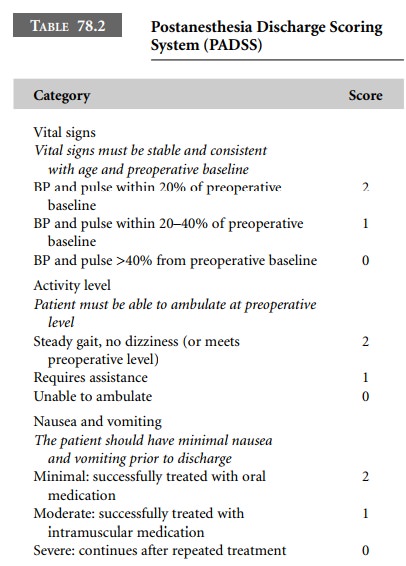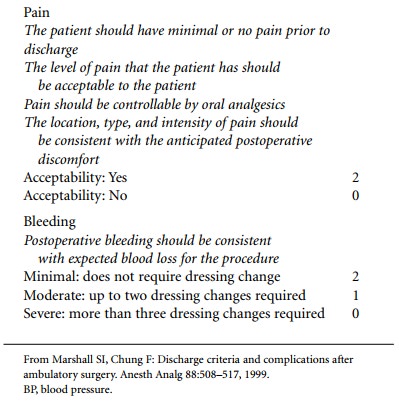Chapter: Clinical Cases in Anesthesia : Office-Based Anesthesia
How will you determine when the patient is ready to be discharged?
How will
you determine when the patient is ready to be discharged?
Strong emphasis is placed on early discharge
because there is usually limited space available. It is important to identify a
set of criteria that helps to determine when a patient can be sent home to
finish recovering.

Recovery itself can be divided into several
phases that can overlap. Phase I, early recovery, generally begins at the end
of an anesthetic and continues until the patient has recovered baseline
activity, respiration, circulation, consciousness, and color. The Aldrete
scoring system or a modification thereof is widely used in postanesthesia care
units (Table 78.1). A score of 9 in the Aldrete system indi-cates that the
patient is ready for phase II recovery. It is the physician’s responsibility to
determine when a patient is ready for discharge from the facility to complete
their recovery at home (phase III). Home readiness criteria include such
parameters as stable vital signs, ability to ambulate, control of surgical
bleeding, pain control, and minimal nausea and vomiting. Marshall and Chung
(1999) developed the Postanesthesia Discharge Scoring System (PADSS) (Table
78.2). When the score is 9 or greater the patient is ready for discharge.


In recent years, the idea of fast-tracking
patients after general anesthesia has received much attention. Fast-tracking
implies the bypassing of the high-care setting of the postanesthesia care unit
and moving the patient directly to an ambulatory surgery unit (ASU). With the
newer anesthetic agents and techniques it is possible to complete early
recovery in the operating room and transfer a patient directly to an ASU. Proposed
fast-track criteria include level of consciousness, physical activity,
hemodynamic stability, respiratory stability, oxygen saturation status,
postoperative pain assessment, and the absence of postoperative nausea and
vomiting. These criteria presented by White incorporate pain and nausea
assessment, which previous systems did not include. Much of the impetus is the
cost-savings potential, which in a hospital setting or ambulatory surgery
center can be significant. It may not be a factor in the office setting where
the same personnel are responsible for both phase I and phase II recovery.
Related Topics